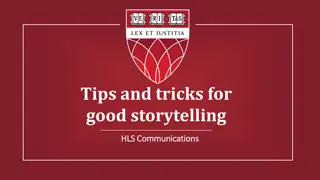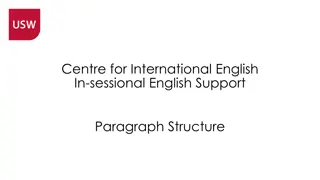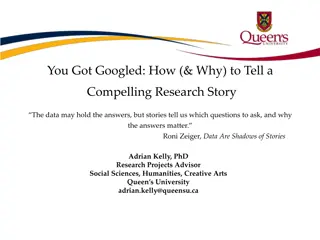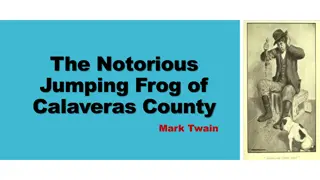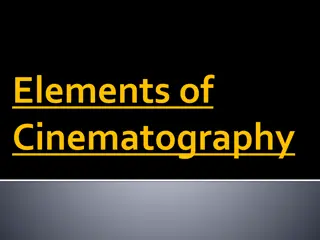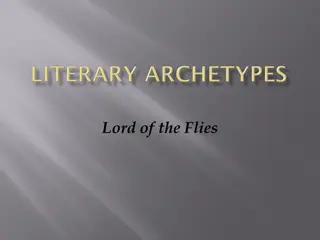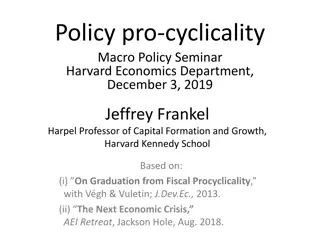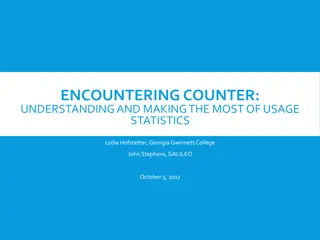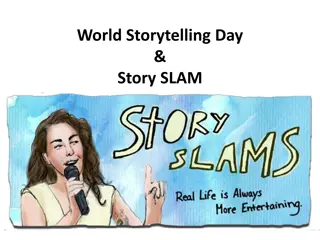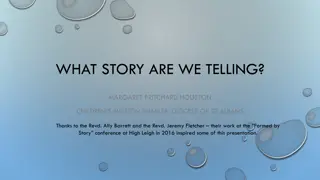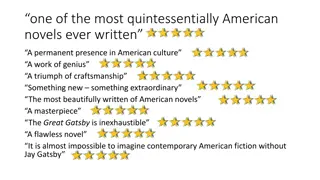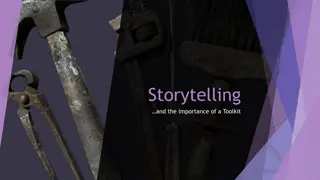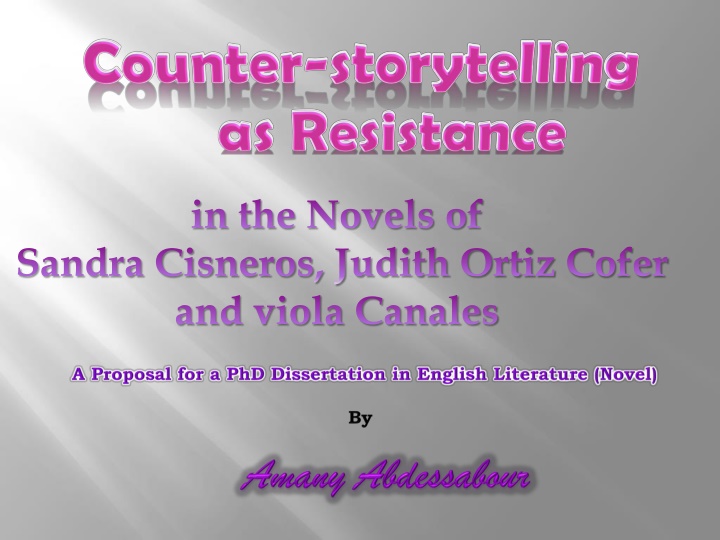
Latino-American Literature: Voices in Novels by Cisneros, Ortiz Cofer, and Canales
Explore the significant influence of Latino-American literature through the unique perspectives of Sandra Cisneros, Judith Ortiz Cofer, and Viola Canales. These authors challenge mainstream narratives, providing authentic portrayals of Latino life in the U.S. Their works offer counter-stories that depict the diverse experiences of Latino-Americans in a compelling and truthful light.
Download Presentation

Please find below an Image/Link to download the presentation.
The content on the website is provided AS IS for your information and personal use only. It may not be sold, licensed, or shared on other websites without obtaining consent from the author. If you encounter any issues during the download, it is possible that the publisher has removed the file from their server.
You are allowed to download the files provided on this website for personal or commercial use, subject to the condition that they are used lawfully. All files are the property of their respective owners.
The content on the website is provided AS IS for your information and personal use only. It may not be sold, licensed, or shared on other websites without obtaining consent from the author.
E N D
Presentation Transcript
in the Novels of Sandra Cisneros, Judith Ortiz Cofer and viola Canales
Latino-American literature is a very significant and distinctive trend in American literature. The Latino population constitutes the second largest growing minority group in the U.S. Historically, minority groups have been powerless and alienated from mainstream culture. As a result, minority children and youth have developed lower self-esteem than Euro-American children.
Also, the economic status of minority groups is much lower than mainstream Americans, and high level jobs are seldom given to them. This has created a cycle of powerlessness among minority families and will unconsciously develop a feeling of despair and a negative self-image among Latino-American children.
Latino-Americans used to be negatively portrayed or stereotypically reflected in mainstream American literature whether intentionally or not. Thus, there is a huge responsibility that lies on Latino-American authors in offering a true- to- life image of Latinos living in the Unites States. Their portrayals would be more real and sincere as they are part of this community and will be more truthful in their depiction than white-American authors.
The proposed study attempts to investigate three novels of three American writers; Sandra Cisneros, Judith Ortiz Cofer, and Viola Canales. The novels selected could be regarded as Counter-narratives or Counter-stories to the mainstream white-American narratives about Latino-Americans. Unlike the mainstream view of Latinos, the selected novels depict the lives of Latino-Americans in the United States from a Latino-American perspective.
A Mexican-American writer who was born in Illinois, Chicago. Cisneros is best known for her novel The House on Mango Street (1984). She also wrote a collection of short stories; Women Hollering Creek and Other Stories (1991), and another novel entitled Caramelo (2002). Cisneros has drawn on many experiences from her own life story in her novel The House on Mango Street (1984). It retells the story of Esperanza Cordero, a Mexican-American girl who lives in a poor barrio in Chicago. It is an influential coming of age story that is partly biographical. The novel depicts a day-to-day snapshots of Esperanza's life.
A Puerto-Rican-American author whose works span a different range of literary genres including poetry, short stories, autobiography essays and young-adult fiction. Cofer's work is strongly influenced with oral storytelling which is an inherited tradition of the Latino culture. Call Me Maria (2004) is Cofer's young-adult novel that narrates the story of Maria, a Puerto Rican girl who moves to New York with her father leaving her mother behind in the island. Maria is caught between two worlds; her father's barrio and her mother's island. She, like many adolescents, is trying to find her way and who she is.
an American writer who is originally from Texas. She has won the Pura Belpr Award in 2006 for her novel, The Tequila Worm (2005). She wrote a short story collection entitled Orange Candy Slices and Other Secret Tales (2001). Her writing is infused with people and places with a very unique cultural background. The Tequila Worm (2005) reflects part of Canales' own life experience. The protagonist, Sofia, who comes from a family of storytellers living in the barrio,was signaled out to receive a scholarship to an elite school in Texas. She left her home and family in the barrio, but she carried all their traditions and magical world with her in Texas. The novel is a coming of age story that portrays a very rich Mexican- American traditions and culture.
Despite the growing interest in contemporary Latino-American literature, not many researchers have yet examined the content of Latino-American Young-Adult literature. Latino-American writers have their own cultural background, of which they are very proud. This sort of pride and cultural manifestation is very present in their writings particularly these directed to children and young adult readers. The staunch adherence of Latino-Americans to their culture and their identification with their ethnic heritage is a very unique and peculiar characteristic of their literature that should be examined.
This uniqueness gives their literature a special flavor and the reader can infer many messages that are indirectly conveyed. In his book, Critical Race Theory: An Introduction, Richard Delgado discusses this attitude of Latinos and called it "nationalism," and he elaborates that "Latino nationalists emphasize cultural pride, preservation of the Spanish language, and ties with Mexico, Puerto Rico, or other homelands. Both Latino and black nationalists deplore passing the effort to deracinate oneself and present oneself as white" (Delgado, 61).
The research topic could be helpful to research community as it sheds more light on the distinctive literary works written by Latino-American writers for young-adult readers. The importance of the study lies on the fact that the Latino-American population constitutes the second largest growing minority group in the U.S. however, very little studies have tackled their writings. The reality of our world becoming a small village behooves us to understand and learn other languages and cultures, and to respect the differences of other people's customs and traditions. Since each minority or ethnic group has its own distinctiveness, the melting pot or the crucible ideology of the American culture is fading out. It should be replaced with an ideology of acceptance of cultural pluralism or cultural mosaic; a multi-ethnic and multi-cultural society.
The importance of the study of Latino-American counter-stories lies on the fact that they preserve the history and traditions of Latinos as a marginalized group whose experiences have never been legitimized within mainstream majoritarian narrative. While the present study investigates some young adult works of Latina-American writers as part of American literature as a whole, it also attempts to showcase their strenuous endeavors to make Latino children or young adults happier to see people like them on books who practice their traditions and speak their language without being prejudiced against or ridiculed. They are allowed through these counter narratives to see their reflections accepted as real and true to life, not distorted, deformed or stereotypically portrayed like the mainstream narratives.
The study is thought to investigate three young-adult novels of three different Latina-American writers; Sandra Cisneros' The House on Mango Street (1984), Judith Ortiz Cofer's Call Me Maria (2004), and Viola Canales' Tequila Worm (2005). The study intends to explore the different perspectives from which these writers attempt to reflect Latino-American society. It is proposed to conduct an in-depth analysis of the three novels selected as a resistant narratives or counter-narratives that on the first hand, resist assimilation to the mainstream Anglo-American or white- American culture, and on the other hand celebrate the Latino heritage.
The study attempts to probe the specific qualities of Latina- Americans' fiction and to investigate the distinctiveness of their literature as "Barrio narratives" or "Border narratives". The purpose of the study is to explore what those Latina writers want to say through their works and to investigate the issues with which they are obsessed and which their writings reflect.
The study is thought to respond to the following questions: What type of literature those Latina-American writers provide? What are their motivations? What do they want to achieve through their literature? Is there any particular message they want to convey or send to their readers? What are these messages? What are the circumstances that moved them to write? What are their recommendations? What distinguishes their writings? 1) 2) 3) 4) 5) 6) 7) 8)
The three selected authors have written very distinguished works. Judith Ortiz Cofer's and Sandra Cisneros's works have spanned a wide array of genres; their works include non-fiction books, multi-genre books, poetry, prose, young-adult literature and children's books. Cisneros have written three novels; The House on Mango Street (1984), Women Hollering Creek and Other Stories (1991) and Caramelo (2002), and many other works including four volumes of poetry and picture books for children.
Judith Cofer is also a very prolific writer. She, like Cisneros, is a multi-talented artist who tried her hands in different genres. Her work spans multi-genre books, pamphlets, three volumes of poetry and children and young-adult books. Her production of young-adult literature includes; If I Could Fly (2011), Call Me Maria (2004), The Meaning of Consuelo (2003), An Island Like You: Stories of the Barrio (1995). She also wrote a novel entitled; The Line of the Sun (1989). Viola Canales is somewhat novice in writing. She has written two novels for young readers; The Tequilla Worm (2005) and Orange Candy Slices and Other Secret Tales (2001), and a volume of poetry entitled, The Little Devil and the Rose (2014).
The study then focuses only on three novels for young- adult readers; Cisneros' The House on Mango Street (1984), Judith Cofer's Call me Maria (2004) and Viola Canales' The Tequila Worm (2005).
Latino-American writers in general have attracted the attention and interest of many scholars and critics because of the unique style of their writings and the distinctiveness of their background. The selected authors; Sandra Cisneros (1954- present), Judith Ortiz Cofer (1952- 2016), and Viola Canales (1957- present), have gained a worldwide recognition and many of their works gained wide acclaim and received many awards. However, no much attention was given to the works selected but Cisneros' The House on Mango Street. Nevertheless, Cisneros novel was analyzed from different perspectives and not as a counter-narrative. The Tequila Worm (2005) and Call Me Maria (2004) have not received sufficient attention or due response from critics.
The selected authors were the subject of many articles in scholarly journals, published theses, dissertations and books such as: The City as a Point of Transition in the lives of Esmeralda Santiago and Judith Ortiz Cofer (2004) by Monica Michelle Joiner. Latina and Latino Voices in Literature: Lives and Works, Updated and Expanded (2003)by Frances Ann Day. Celebrating Cuentos: Transnational Latina Narratives in the Twenty- First Century: The Politics of Gender, Race and Migration (2009) by Juanita Heredia. "'En Otras Voces': Multiple Voices in Sandra Cisneros' The House on Mango Street." (2001) by Beth L. Brunk, and "'Cold/Hot, English/Spanish': The Puerto Rican American Divide in Judith Ortiz Cofer's Silent Dancing." (2003), by Teresa Derrickson.
Hence, there is an urgent need for a deeper study of the selected Latino-American texts, particularly because no many researchers have examined them as young adult literature or as counter narratives. Moreover, no one has conducted a cross- sectional or a comparative study of their works, because each novelist is examined individually. Therefore, the proposed study's contribution will be to analyze further those young adult texts from a different approach as counter narratives, by combining and comparing these novels together.
The current research draws on a two-tiered methodological approach; close textual analysis of primary source materials, and the interpretation of primary texts through theoretical frameworks. It proposes to adopt an in-depth analysis of three young-adult novels by three American writers in the light of Latino Critical Race Theory or (LatCrit), which is a theoretical branch and an offshoot of Critical Race Theory or (CRT). Critical Race Theory movement is defined as a collection of activists and scholars engaged in studying and transforming the relationship among race, racism, and power (Delgado and Stefancic, 2).
Latino critical theory (LatCrit) emerged as an organized group in 1995 and has become a forceful movement in CRT scholarship and activism. LatCrit is a theoretical branch extending from CRT, which examines experiences that are pertinent to the Latina/o community such as immigration status, language, ethnicity, and culture. In order to integrate critical race theory with the experiences of Latinos, Counter-storytelling as a technique or a method will be applied. Counter-storytelling is a method of telling the stories of people who are silenced or who are at the margins of society, and it is also a tool of exposing and challenging the standard or majoritarian stories of racial privilege.
Latino-American Counter-stories defy the traditional monolingual form of the majoritarian mainstream narratives by adopting Code- Switching and shifting from English to Spanish within the text. Counter narratives may also "serve as a powerful psychic function for minority communities [These] stories can give them voice and reveal that others have similar experiences. Stories can name a type of discrimination; once named, it can be combated" (Delgado et al 43). The theoretical framework of the study draws on concepts like; Storytelling, Counter-storytelling, Barrio narrative, Young-Adult Latino-American literature, Border literature, Bilingualism, Code- switching, Biculturalism, Multiculturalism etc.
The proposed study will be divided into a preface, four chapters and a conclusion. Chapter I. INTRODUCTION: LATINA-AMERICAN WRITERS: This chapter will provide a brief background of Latino-American fiction in general with special reference to the lives, careers and works of Sandra Cisneros (1954- present), Judith Ortiz Cofer (1952- 2016) and Viola Canales (1957-present). It will also provide an overall view of the selected works and how the researcher will analyze them as counter narratives.
Chapter One will be a discussion of the main concepts and terms that will be used in analyzing the works selected. Chapter II. COUNTER-STORYTELLING IN BARRIO NARRATIVES : Chapter Two attempts to analyze the works selected as Latino counter-narratives that celebrate Latino or Hispanic heritage. It attempts to testify how those Latina writers adhere to their original culture and how they to some extent glorify and propagandize their language and culture through their resistance to the mainstream writing.
Chapter III. THE AUTOBIOGRAPHICAL ELEMENT: Here the dissertation proposes that there is some sort of similarity between the authors' life stories and the stories narrated in their novels. This indicates that there is an autobiographical aspect in the selected novels which is noteworthy and should not be overlooked. The chapter will tackle the suggested autobiographical elements found in the selected novels.
Chapter IV. SPANGLISH: CODE-SWITCHING IN LATINO NARRATIVES: This chapter will investigate the Latina-American writers use of Code-Switching, the alternation between Spanish and English in the course of discourse, and how it is used as a form of resistance. Chapter Four will discuss how Code- Switching is used in Latino narratives, and whether it is deliberate or accidental, and what are the real reasons for inserting Spanish words within the English text. The chapter also will examine if Code-Switching is a barrier to understanding or a means of clarification, elaboration and emphasis.
Chapter V. TECHNIQUE OF LATINO NARRATIVE : Chapter Five attempts to examine the form of the novels and their technical aspects as postmodern texts that are different from the conventional and traditional form of literary texts. Latino- American writers are known to be gifted in their technique of writing. They are thought to be very skilled architects in their craft. This chapter will tackle the distinct features of the postmodern technicalities employed by those Latina writers as a means of resistance and defiance to the conventional certified techniques of writing.
The Conclusion will be an overall assessment of the themes and issues discussed in the thesis. It will feature the researcher's viewpoint of the selected works. *******

